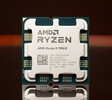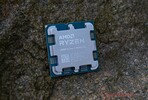AMD Ryzen 9 7900X vs AMD Ryzen 9 7950X3D
AMD Ryzen 9 7900X
► remove from comparison
The AMD Ryzen 9 7900X is a fast high-end desktop processor of the Raphael series. It offers 12 cores based on the Zen 4 architecture that supports hyperthreading (24 threads). The cores clock from 4.7 (base) up to 5.7 GHz (single core boost). When all 12 cores are fully loaded, 5.1 GHz is the max. clock speed. The 7900X is the second fastest Ryzen at launch, only bested by the Ryzen 9 7950X with 4 more cores.
The performance of the R9 7900X is clearly better than the old Ryzen 9 5900X thanks to the improved architecture and modern 5nm process. Compared to Intels Raptor Lake Core i9-13700K the single-core performance is slightly lower and the multi-core performance slightly faster. The gaming performance is a bit lower, and is on average only on par with the Core i5-13600K and also lower than the old Ryzen 7 5800X3D.
The Raphael series still uses a chiplet design with two CCD-clusters (each with 8 possible cores) in 5nm and an IO-die (including the memory controller and the Radeon Graphics iGPU) in 6nm.
AMD Ryzen 9 7950X3D
► remove from comparison
The AMD Ryzen 9 7950X3D is a high-end desktop processor of the Raphael series with 16 cores and SMT (Simultaneous Multithreading), which means it can process up to 32 threads simultaneously. With the release in February 2023, the Ryzen 9 7950X3D is AMD's fastest consumer processor and the new top model of the 7000 series. The CPU cores clock from 4.2 GHz (base clock) up to 5.7 GHz (single core Turbo). In addition, the AMD Ryzen 9 7950X3D has a CCD with 8 cores that can access the fast 3D V-cache, which offers considerably more gaming performance.
The performance of the AMD Ryzen 9 7950X3D is consistently excellent in all applications tested. In addition, AMD was again able to increase the single-thread performance compared to the non-X3D models. Nevertheless, the lower base clock compared to the AMD Ryzen 9 7950X means that a small drop in multi-thread performance has to be accepted.
The internal structure of the processor is comparable to the previous AMD Ryzen 9 7950X. The AMD Ryzen 9 7950X3D is also still based on the chiplet design consisting of two CCD clusters with 8 cores each. However, the two CCDs differ significantly from each other because one offers the fast 3D V-Cache, which primarily improves gaming performance. In testing, the AMD Ryzen 9 7950X3D was able to put the Intel Core i9-13900K in second place and is the fastest gaming CPU on the market at the time of testing.
The AMD Ryzen 9 7950X3D is an extremely energy-efficient CPU with up to 162 watts (PPT) and is significantly more frugal under load than an AMD Ryzen 9 7950X (max. 230 watts).
| Model | AMD Ryzen 9 7900X | AMD Ryzen 9 7950X3D | |||||||||||||||||||||||||||||||||||||||||||||||||||||||||||||||||
| Codename | Raphael (Zen4) | Raphael (Zen4) | |||||||||||||||||||||||||||||||||||||||||||||||||||||||||||||||||
| Series | AMD Raphael (Zen 4, Ryzen 7000) | AMD Raphael (Zen 4, Ryzen 7000) | |||||||||||||||||||||||||||||||||||||||||||||||||||||||||||||||||
| Series: Raphael (Zen 4, Ryzen 7000) Raphael (Zen4) |
|
| |||||||||||||||||||||||||||||||||||||||||||||||||||||||||||||||||
| Clock | 4700 - 5600 MHz | 4200 - 5700 MHz | |||||||||||||||||||||||||||||||||||||||||||||||||||||||||||||||||
| L1 Cache | 768 KB | 1 MB | |||||||||||||||||||||||||||||||||||||||||||||||||||||||||||||||||
| L2 Cache | 12 MB | 16 MB | |||||||||||||||||||||||||||||||||||||||||||||||||||||||||||||||||
| L3 Cache | 64 MB | 128 MB | |||||||||||||||||||||||||||||||||||||||||||||||||||||||||||||||||
| Cores / Threads | 12 / 24 | 16 / 32 16 x 5.7 GHz AMD Zen 4 | |||||||||||||||||||||||||||||||||||||||||||||||||||||||||||||||||
| TDP | 170 Watt | 120 Watt | |||||||||||||||||||||||||||||||||||||||||||||||||||||||||||||||||
| Transistors | CCD: 6,5 Mrd + IOD: 3,4 Mrd Million | 13140 Million | |||||||||||||||||||||||||||||||||||||||||||||||||||||||||||||||||
| Technology | 5 nm (CCD), 6 nm (I/O) nm | 5 nm | |||||||||||||||||||||||||||||||||||||||||||||||||||||||||||||||||
| Voltage | 0.650 - 1.475V V | ||||||||||||||||||||||||||||||||||||||||||||||||||||||||||||||||||
| Die Size | 2x 70 (CCD) mm2 + 122 (I/O) mm2 | 263 mm2 | |||||||||||||||||||||||||||||||||||||||||||||||||||||||||||||||||
| max. Temp. | 95 °C | 89 °C | |||||||||||||||||||||||||||||||||||||||||||||||||||||||||||||||||
| Socket | AM5 (LGA 1718) | AM5 (LGA 1718) | |||||||||||||||||||||||||||||||||||||||||||||||||||||||||||||||||
| Features | MMX(+), SSE, SSE2, SSE3, SSSE3, SSE4.1, SSE4.2, SSE4A, x86-64, AMD-V, AES, AVX, AVX2, AVX512F, FMA3, SHA, Precision Boost 2 | MMX(+), SSE, SSE2, SSE3, SSSE3, SSE4.1, SSE4.2, SSE4A, x86-64, AMD-V, AES, AVX, AVX2, AVX512F, FMA3, SHA, XFR2, Precision Boost 2 | |||||||||||||||||||||||||||||||||||||||||||||||||||||||||||||||||
| iGPU | AMD Radeon Graphics (Ryzen 7000) | AMD Radeon Graphics (Ryzen 7000) (400 - 2200 MHz) | |||||||||||||||||||||||||||||||||||||||||||||||||||||||||||||||||
| Architecture | x86 | x86 | |||||||||||||||||||||||||||||||||||||||||||||||||||||||||||||||||
| Announced | |||||||||||||||||||||||||||||||||||||||||||||||||||||||||||||||||||
| $699 U.S. | |||||||||||||||||||||||||||||||||||||||||||||||||||||||||||||||||||
| Manufacturer | www.amd.com |
Benchmarks
Average Benchmarks AMD Ryzen 9 7900X → 0% n=0
Average Benchmarks AMD Ryzen 9 7950X3D → 0% n=0
* Smaller numbers mean a higher performance
1 This benchmark is not used for the average calculation












